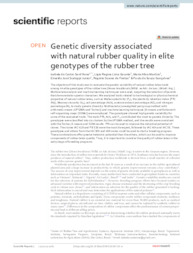Genetic diversity associated with natural rubber quality in elite genotypes of the rubber tree.
Genetic diversity associated with natural rubber quality in elite genotypes of the rubber tree.
Autoria: SANT'ANNA, I. C.; GOUVÊA, L. R. L.; MARTINS, M. A.; SCALOPPI JUNIOR, E. J.; FREITAS, R. S.; GONÇALVES, P. S.
Resumo: The objective of this study was to evaluate the genetic variability of natural rubber latex traits among 44 elite genotypes of the rubber tree [Hevea brasiliensis (Willd. ex Adr. de Juss.) Müell. Arg.]. Multivariate analysis and machine learning techniques were used, targeting the selection of parents that demonstrate superior characters. We analyzed traits related to technological or physicochemical properties of natural rubber latex, such as Wallace plasticity (P0), the plasticity retention index [PRI (%)], Mooney viscosity (VR), ash percentage (Ash), acetone extract percentage (AE), and nitrogen percentage (N), to study genetic diversity. Multivariate [unweighted pair group method with arithmetic means (UPGMA) and Tocher)] and machine learning techniques [K-means and Kohonen’s self-organizing maps (SOMs)] were employed. The genotypes showed high genetic variability for some of the evaluated traits. The traits PRI, Ash, and PO contributed the most to genetic diversity. The genotypes were classifed into six clusters by the UPGMA method, and the results were consistent with the Tocher, K-means and SOM results. PRI can be used to improve the industrial potential of clones. The clones IAC 418 and PB 326 were the most divergent, followed by IAC 404 and IAC 56. These genotypes and others from the IAC 500 and 400 series could be used to start a breeding program. These combinations ofer greater heterotic potential than the others, which can be used to improve components of rubber latex quality. Thus, it is important to consider the quality of rubber latex in the early stage of breeding programs
Ano de publicação: 2021
Tipo de publicação: Artigo de periódico
Unidade: Embrapa Instrumentação
Palavras-chave: Amazon region, Rubber agricultural
Observações
1 - Por padrão são exibidas publicações dos últimos 20 anos. Para encontrar publicações mais antigas, configure o filtro ano de publicação, colocando o ano a partir do qual você deseja encontrar publicações. O filtro está na coluna da esquerda na busca acima.
2 - Para ler algumas publicações da Embrapa (apenas as que estão em formato ePub), é necessário ter, no celular ou computador, um desses softwares gratuitos. Sistemas Android: Google Play Livros; IOS: iBooks; Windows e Linux: software Calibre.
Acesse outras publicações
Acesse a Base de Dados da Pesquisa Agropecuária (BDPA) para consultar o acervo completo das bibliotecas da Embrapa.

